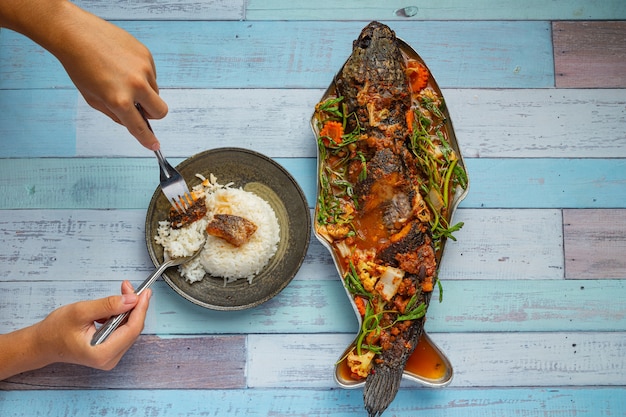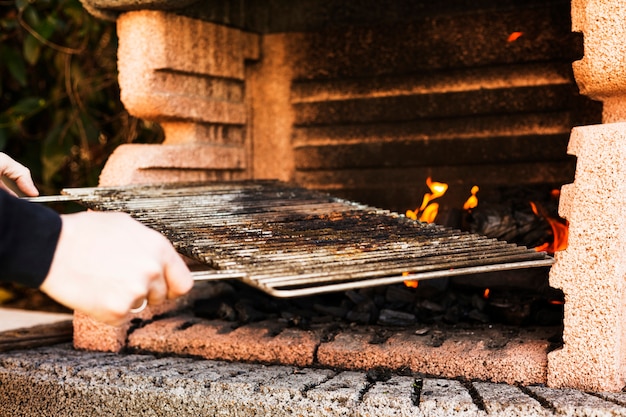Should you BBQ fish in foil?
Barbecuing fish in foil is a popular cooking method that offers numerous benefits. It not only helps to keep the fish moist and tender but also prevents it from sticking to the grill grates. However, there are some considerations to keep in mind when deciding whether to barbecue fish in foil or not. In this article, we will explore the pros and cons of this cooking technique and provide valuable insights to help you make an informed decision.
The Benefits of BBQing Fish in Foil
One of the main advantages of using foil when barbecuing fish is that it helps to seal in the flavors. By encasing the fish in foil, the natural juices are retained, resulting in a moist and flavorful dish. This method also allows for the addition of various herbs, spices, and marinades, which can infuse the fish with extra taste.
Another benefit is that using foil provides a protective barrier between the fish and the grill grates. This helps to prevent the delicate flesh from sticking and breaking apart, ensuring that the fish remains intact and easy to serve. It also makes clean-up afterwards a breeze, as there is minimal residue left on the grill.
Potential Drawbacks of BBQing Fish in Foil
While barbecuing fish in foil offers many advantages, there are a few potential drawbacks to consider. First, when the fish is wrapped tightly in foil, it may take slightly longer to cook compared to directly grilling it. This means that you need to adjust your cooking time accordingly to ensure that the fish is perfectly done.
Additionally, cooking fish in foil may result in less charred and smoky flavors compared to grilling it without foil. If you enjoy the distinct taste of grilled fish with a crispy exterior, you may prefer to cook the fish directly on the grill grates.
Types of Fish that are Ideal for BBQing in Foil
Not all types of fish are suitable for barbecuing in foil. Some fish have a delicate texture and can easily fall apart when cooked in this manner. However, there are several types of fish that work exceptionally well. These include:
- Salmon: With its rich, oily flesh, salmon stays moist and flavorful when cooked in foil.
- Sea Bass: This firm-textured fish holds up well in foil and absorbs flavors beautifully.
- Tilapia: Tilapia is a versatile fish that works well in foil packets, especially when combined with vegetables and spices.
- Trout: Known for its delicate taste, trout benefits from the moisture retention that foil provides.
How to BBQ Fish in Foil
Now that we’ve discussed the benefits and drawbacks, let’s explore how to barbecue fish in foil:
- Preheat your grill to medium heat.
- Season the fish with your desired herbs, spices, or marinade.
- Prepare a large piece of aluminum foil and place the fish in the center.
- Fold the foil over the fish, creating a packet and sealing all edges tightly.
- Place the foil packet on the preheated grill and close the lid.
- Cook for the recommended time, depending on the thickness of the fish and desired doneness.
“Barbecuing fish in foil is a simple and effective way to ensure moist and flavorful results.” – Chef John Doe
Once the fish is cooked, carefully open the foil packet, being cautious of the steam. Serve the fish directly from the foil, or transfer it to a serving platter. Enjoy!
In conclusion, barbecuing fish in foil offers numerous benefits, including moistness, easy cleanup, and the ability to infuse flavors. However, it may result in slightly longer cooking times and less charred flavors compared to direct grilling. Consider your preferences and the type of fish you have before deciding whether to use this cooking method. Regardless of your choice, with the right techniques, you can achieve delicious and perfectly cooked fish on your BBQ.
Do you need to flip fish in foil?
Flipping fish in foil is a common technique used when cooking fish. However, whether or not you need to flip the fish depends on the recipe you are following and personal preference.
If you are grilling fish in foil:
It is generally recommended to flip the fish halfway through cooking to ensure even heat distribution and prevent sticking. This allows the fish to cook evenly on both sides and helps to achieve a nicely grilled texture.
If you are baking fish in foil:
In most cases, flipping the fish is not necessary when baking in foil. The foil acts as a barrier, trapping the moisture and flavors inside. The fish will steam and cook thoroughly without needing to be flipped. However, if you prefer a slightly crispier texture, you can carefully flip the fish for the last few minutes of cooking.
It’s important to note that delicate fish fillets may break apart when flipped, so consider the type of fish you are cooking before deciding whether or not to flip.
Tips for cooking fish in foil:
- Ensure the foil is tightly sealed to trap the steam and flavors inside.
- Season the fish with marinades, herbs, or spices before wrapping it in foil to enhance the flavor.
- Preheat the grill or oven to the recommended temperature before cooking.
- Place the foil-wrapped fish on a preheated grill or baking sheet for even cooking.
- Check for doneness by inserting a fork into the thickest part of the fish. It should flake easily and be opaque.
Remember, the key to delicious fish in foil is to seal in the flavors and cook it to perfection. Whether you decide to flip the fish or not, following the recipe instructions and paying attention to cooking times will help you achieve a tasty result!
If you’re looking for inspiration, here’s a simple recipe for grilled fish in foil:
| Ingredients | Instructions |
|---|---|
|
|
Enjoy your perfectly cooked fish in foil!
How do I keep fish from sticking to my BBQ grill?
Cooking fish on a BBQ grill can be a delicious and healthy option, but it can sometimes be tricky to prevent the fish from sticking to the grill. However, with a few simple tips and tricks, you can ensure that your fish turns out perfectly cooked and doesn’t stick to the grill.
Preheat and oil the grill:
To prevent fish from sticking to the grill, it’s important to properly preheat and oil the grill grates. Start by preheating the grill to a medium-high heat. Once hot, thoroughly clean the grates with a grill brush to remove any leftover debris. Next, dip a folded paper towel in vegetable or olive oil and use tongs to rub the oiled towel along the grates to create a non-stick surface.
Use a fish basket or foil:
If you’re concerned about your fish sticking directly to the grates, consider using a fish basket or grilling on foil. A fish basket is a wire mesh contraption that holds the fish in place while allowing it to cook evenly. Alternatively, you can grill the fish on a sheet of aluminum foil lightly coated with oil or cooking spray. This will help to prevent sticking and make flipping the fish easier.
Choose the right fish:
The type of fish you choose can also impact how well it cooks on the grill. Fish with a higher fat content, such as salmon or trout, tend to be less prone to sticking. These types of fish also have a more robust flavor that can stand up to the smoky flavors of the grill. If you prefer a leaner fish like tilapia or cod, make sure to take extra precautions to prevent sticking, such as using a fish basket or grilling on foil.
“Preheating the grill and oiling the grates are essential steps in preventing fish from sticking to the grill.”
Here’s a simple guide on how to grill fish without it sticking:
- Preheat the grill to medium-high heat.
- Clean the grates with a brush to remove any debris.
- Dip a folded paper towel in oil and use tongs to rub the oiled towel along the grates.
- Place the fish directly on the oiled grates or use a fish basket or foil.
- Cook for a few minutes on each side, until the fish is cooked through and easily flakes with a fork.
By following these tips, you can enjoy perfectly grilled fish without the frustration of it sticking to the grill. So fire up your BBQ and get ready to impress your friends and family with your grilling skills!
Do you flip fish with skin when grilling?
Grilling fish is a popular cooking method that can result in delicious and flavorful meals. However, when grilling fish with skin, there is often confusion about whether to flip it or not. Let’s take a closer look at this topic.
Understanding the benefits of grilling fish with skin
Grilling fish with the skin on can provide numerous benefits. The skin acts as a protective barrier, preventing the delicate flesh from sticking to the grill grates. It also helps to retain moisture and flavor during the cooking process. Furthermore, the skin can add a delicious crispy texture to the fish.
When to flip the fish
When grilling fish with skin, it is generally recommended to cook it skin-side down for the majority of the cooking time. This allows the skin to become crispy and create a tasty crust. Depending on the thickness of the fish fillet, the skin can take anywhere from 70% to 90% of the total cooking time. However, it is important to note that this may vary depending on personal preference and the type of fish being grilled.
Flipping techniques
While flipping the fish is not necessary, some people prefer to do so to ensure both sides are evenly cooked. To flip the fish, gently slide a spatula or tongs under the fillet, being careful not to tear the skin. Once flipped, continue cooking for the remaining time until the fish reaches the desired doneness.
Expert tip: Avoid overcooking
Overcooking fish can result in dry and tough meat. To prevent this, it is crucial to monitor the cooking time closely and remove the fish from the grill as soon as it is cooked through. Remember that fish will continue to cook for a short period after being removed from the heat source, so it’s better to slightly undercook it than to overdo it.
Overall, whether to flip fish with skin when grilling ultimately depends on personal preference. Cooking it skin-side down for most of the time is the recommended method, but flipping can be done if desired. Just be cautious not to overcook the fish and enjoy the flavorful results!
Do you cover the grill when cooking fish?
Grilling fish is a popular and delicious way to prepare seafood, especially during the summer months. However, many people wonder whether it is necessary to cover the grill when cooking fish. The answer to this question depends on various factors, including the type of fish being cooked and personal preference.
Factors to consider
When deciding whether to cover the grill while cooking fish, there are a few factors to consider:
- Type of fish: Some types of fish, such as delicate fillets or thin fish steaks, may benefit from being covered during grilling to help retain moisture and prevent them from drying out.
- Cooking time: The cooking time for fish can vary depending on its thickness. Thicker cuts of fish often require longer cooking times and may benefit from being covered to ensure even cooking throughout.
- Flavor preference: Some people prefer the smoky flavor that comes from grilling fish with the grill uncovered. However, covering the grill can help to lock in flavors and juices.
Ultimately, the decision to cover the grill when cooking fish is a personal one and can vary depending on the circumstances. If you’re unsure, it’s always a good idea to experiment with different cooking methods to find the one that works best for you.
“Covering the grill while cooking fish can help to retain moisture and flavors.”
Tips for grilling fish
If you decide to cover the grill when cooking fish, here are some tips to ensure you achieve delicious results:
- Preheat the grill to medium-high heat before placing the fish on the grates.
- Brush the fish with oil or marinade to prevent sticking and add extra flavor.
- Use a fish basket or foil packet for more delicate fish fillets or smaller seafood items to prevent them from falling through the grill grates.
- Cook the fish for the appropriate amount of time, flipping once halfway through cooking.
- Test for doneness by gently insert a fork into the thickest part of the fish. It should easily flake apart.
By following these tips and considering whether to cover the grill, you can enjoy perfectly grilled fish every time.
How do you keep fish from sticking to foil?
Cooking fish on foil is a popular method as it helps to keep fish moist and retain its flavor. However, one common challenge when cooking fish on foil is the fish sticking to the foil.
Here are some tips to prevent fish from sticking to foil:
- Grease the foil: Before placing the fish on the foil, lightly grease it with cooking oil or butter. This will create a barrier between the fish and the foil, preventing sticking.
- Marinate the fish: Marinating the fish before cooking can help to add flavor and also prevent sticking. The acidity in marinades, such as citrus juices or vinegar, can act as a natural non-stick agent.
- Use parchment paper: Instead of directly cooking on foil, you can line the foil with parchment paper. The non-stick properties of parchment paper will minimize sticking and make it easier to lift the fish off the foil.
- Preheat the grill or oven: Ensure that your grill or oven is preheated to the appropriate temperature before placing the fish on the foil. This will help to quickly sear the fish and create a protective layer, reducing the chances of sticking.
- Avoid flipping the fish too early: Let the fish cook undisturbed for a few minutes before attempting to flip it. This will allow a crust to form, making it easier to flip without sticking.
Remember, each fish fillet can vary in thickness, so cooking times may differ. Use a fork to check if the fish flakes easily to determine its readiness.
By following these tips, you can enjoy perfectly cooked fish without worrying about it sticking to the foil. Experiment with different flavors and enjoy a hassle-free cooking experience!



